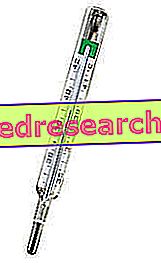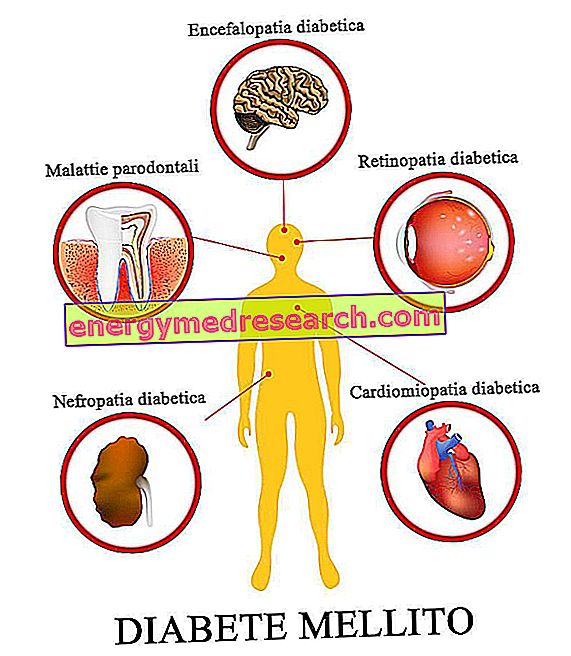Generality
The low minimum pressure is the medical condition in which the diastolic pressure value is constantly lower than 60 mmHg.
In general, the low minimum pressure falls within a context of hypotension, therefore in a state in which even the systolic pressure is constantly lower than the norm (therefore at 90 mmHg).
Brief review of the concept of arterial pressure and low blood pressure

Measured in millimeters of mercury ( mmHg ) and in a state of rest, blood pressure is usually defined by the values of systolic pressure and diastolic pressure :
- the systolic pressure (or maximum or " maximum " pressure) is the arterial pressure of when the heart contracts
- the diastolic pressure (or minimum or " minimum " pressure) is the arterial pressure of when the heart is relaxing.
In a healthy individual, resting blood pressure can have systolic blood pressure values between 90 and 120 mmHg and diastolic blood pressure values between 60 and 80 mmHg.
According to the medical-scientific community, the optimal arterial pressure at rest is equal to or slightly less than 120 (p. Systolic) / 80 (p. Diastolic) mmHg.
The permanent drop in blood pressure below 90/60 mmHg lays the foundation for talking about a medical condition known as hypotension or low blood pressure .
Which factors the blood pressure value depends on:
- Force of contraction of the heart
- Systolic range
- Heart rate
- Resistance in peripheral arteries
- Elasticity of the aorta and large arteries (vascular compliance)
- Intravascular
What is the low minimum pressure?
The low minimum pressure is the condition in which the diastolic pressure is constantly lower than the value of 60 mmHg, ie the pressure level for the "minimum" that marks the border between the state of normal pressure and the state of hypotension.
In other words, with the terminology "low minimum pressure" the doctors refer to a state whose peculiarity is a diastolic pressure at rest of less than 60 mmHg.
As a rule, the low minimum pressure falls within a context of hypotension, therefore in a state in which even the systolic pressure is constantly lower than the norm (therefore at 90 mmHg).
Hypotension and hypertension
Hypotension is the exact opposite of hypertension or high blood pressure .
Hypertension is the condition characterized by arterial pressure values at rest above 140/90 mmHg.
High blood pressure is a serious clinical circumstance, associated with a significant increase in cardiovascular risk .
Causes
A low minimum pressure can be the result of:
- A constitutional hypotension . Doctors call constitutional hypotension the mild hypotensive state which, in carriers, is something physiological. There are, in fact, individuals who constantly present low blood pressure levels, almost never affected (a symptomatology is lacking), because for them it is a matter of pure normality.
For some, constitutional hypotension is a condition devoid of apparent causes (that is, they always have low pressure and their reason cannot be identified); for someone else, constitutional hypotension is a recurring condition in one's family, so it presumably has a genetic-hereditary basis; finally, for someone else, it is the result of a regular and high level sporting practice.
On the basis of reliable (and surprising) scientific studies, constitutional hypotension would be something positive for the health of the person who carries it, so much so that the doctors define the aforementioned hypotensive state with the term benign.
- Pathological hypotension . By pathological hypotension, doctors mean a more or less severe hypotensive state, which depends on the presence of a disease or a medical condition. Unlike constitutional hypotension, pathological hypotension is the cause of symptoms, the severity of which depends, very often, on the extent of the blood pressure drop.
Among the diseases and medical conditions potentially responsible for pathological hypotension, are: Addison's disease, anemia due to folate deficiency or vitamin B12, episodes of anaphylactic shock, dehydration, myocardial infarction, heart failure congestive, some forms of arrhythmia, bradycardia, valvulopathies, pulmonary embolism, septic shock, acidosis, severe traumatic brain injury and spinal cord injuries.
- Drug hypotension ( iatrogenic hypotension ). For hypotension due to drugs, the experts intend all those hypotensive states, more or less severe, that result from the constant, and sometimes incorrect, assumption of certain medicines.
Medications that can cause hypotension include: calcium channel blockers, trinitrina (or nitroglycerin), angiotensin II receptor antagonists, alpha-blockers, anesthetics used for spinal anesthesia, diuretics, beta - blockers, narcotics, tricyclic antidepressants, levodopa combined with carbidopa and some drugs for erectile dysfunction (eg: Viagra, Levitra or Cialis) in association with nitroglierin.
It is interesting and curious to point out to readers that some of the aforementioned drugs (calcium channel blockers, diuretics, angiotensin II receptor antagonists and beta-blockers) are specifically indicated for the treatment of hypertension, ie the condition opposite to hypotension. A reduction in blood pressure levels due to the use of an antihypertensive drug - that is to say acting against high blood pressure - can indicate two things: either the dosage prescribed by the doctor was too high or the patient took a larger pharmacological dose than expected.
- A pregnancy hypotension . Pregnancy is typically accompanied by a decrease in blood pressure, both in the maximum values and in the minimum values, due to the important peripheral vasodilation induced by progesterone (a sex hormone fundamental for the correct development of fetal growth).
Normally, in the first 24 weeks of gestation, there is an average drop in systolic blood pressure of around 5-10 mmHg, and an average decrease in diastolic pressure greater than 10 mmHg.
The hypotension degrees
Hypotension can have different degrees of severity:- It is mild, if the blood pressure levels are between 90/60 mmHg and 60/40 mmHg;
- It is of intermediate grade, if the pressure levels are between 60/40 mmHg and 50/33 mmHg;
- It is severe, if the pressure levels are less than 50/33 mmHg.
Clearly, the more severe the degree of hypotension, the worse are the health conditions in which the patient concerned is.
Symptoms and complications
The presence of a low minimum pressure and of the hypotensive state of which the latter is a part may be asymptomatic - that is, without symptoms - or symptomatic, that is responsible for a certain symptomatological picture.
In general, the lack of symptoms in spite of a low minimum pressure and a hypotensive state is typical - as was anticipated in part - of cases of constitutional hypotension, while the presence of a certain symptomatology is a peculiarity of cases of pathological hypotension, hypotension due to drugs and hypotension due to pregnancy.
What are the symptoms of low minimum pressure?
The typical symptomatological picture of when the low minimum pressure is part of a symptomatic hypotensive state includes:
- Dizziness, dizziness and confusion;
- Blurred vision;
- Sense of fainting that sometimes results in real fainting ( syncope );
- Nausea and vomit;
- Concentration problems;
- Sense of instability;
- Palpitations.
Complications
When the low minimum pressure falls within a context of severe hypotension (for example following a serious pathology), the organs of the person concerned no longer receive the amount of blood that allows them to stay healthy and function at their best.
If the appropriate treatments are lacking, this inadequate blood supply and the consequent suffering that the body faces may cause the patient to enter a state of shock.
Characterized by pallor, weak and rapid pulse, rapid and shallow breathing, and cold sweating, the shock, in the absence of an emergency therapy (therefore immediate), can have deadly consequences.
OTHER COMPLICATIONS
Fainting episodes to which an individual with low symptomatic low blood pressure is subject can lead to injuries and trauma from falling . It is not infrequent, in fact, that people who have fainted from low blood pressure suffer limb fractures or brain traumas.
Why is low minimum pressure causing symptoms?
A low pressure in the maximum values and in the minimum values becomes symptomatic when the effects it produces on the blood circulation are responsible for a cerebral suffering.
Thus, it is based on the degree of brain suffering that the symptoms can be more or less severe. In fact, a mild cerebral suffering causes slight disturbances, such as dizziness in getting up quickly from a lying position; on the contrary, severe cerebral suffering causes important manifestations, such as syncope (or fainting).
Concerning syncope, this event is a real defense mechanism that the organism implements in order to protect itself from the negative effects of an excessive drop in blood pressure. In fact, the lying position that leads to the fainting causes the blood to encounter less difficulty in its path and more easily reach the heart and the brain.
Curiosity: why do people with low constitutional pressure do not faint?
The body of a person with constitutional hypotension has learned to effectively compensate for this situation, thanks to an adjustment of the blood supply to the vital organs.
This adjustment is what avoids fainting episodes.
Diagnosis
The low minimum pressure, and the hypotensive state to which it belongs, can be easily diagnosed by simply measuring blood pressure, using a sphygmomanometer .
However, an accurate diagnosis of low minimum pressure (and hypotension) cannot be limited to the simple observation of reduced resting blood pressure levels, but must also focus on the search for the triggering causes and on the characteristics of the ongoing problem. This explains why the doctors, faced with a case of hypotension, subject the patient to an accurate physical examination and to a precise anamnesis, sometimes even prescribing:
- Blood tests ;
- Urine tests ;
- An electrocardiogram, an echocardiogram and an exercise test ;
- The pressure holter ;
- Radiological examinations, such as chest CT or chest radiography;
- The so-called passive orthostatic stimulation test ;
Why look for the causes of the low minimum pressure?
The identification of the conditions underlying a low minimum pressure is important, because it allows the most appropriate therapy planning.
Therapy
When the low minimum pressure lacks an associated symptomatology and, from the diagnostic tests carried out, appears to be part of a constitutional hypotensive state, no specific treatment or treatment is generally necessary. As stated, in fact, constitutional hypotension is not a danger to the health of the person who carries it.
The speech changes considerably when the low minimum pressure and the hypotensive state to which it belongs are symptomatic and depend on a very specific cause. In such circumstances, in fact, the current condition requires a specific therapy against the triggering factor (causal therapy).
Useful remedies against symptomatic constitutional low blood pressure
Sometimes, even the low minimum pressure resulting from constitutional hypotension can cause a certain symptomatic picture; however, in these situations, rather than symptoms it would be better to talk about annoyances.
According to the doctors, the best advice against such discomforts is:
- Increase your water and salt intake (so drink a few more glasses of water and slightly increase the amount of salt in your diet);
- Avoid excessive consumption of alcohol;
- Avoid caffeine (especially in the evening and before bedtime);
- Wear compressive elastic stockings (as they favor venous return from the lower limbs to the heart);
- Avoid eating too large meals;
- Get used to slowly moving from lying to standing.
It is necessary to point out that the possibility of a symptomatology associated with a low minimum pressure, in a context of constitutional hypotension, is more frequent in the summer months - so when it is hot - because high temperature is a factor favoring the lowering of arterial pressure (therefore, in a person already hypothesized by nature, the heat is responsible for a further reduction in blood pressure).
Examples of causal therapy in symptomatic cases of low minimum pressure
When the low minimum pressure depends on a very specific trigger, which can be a disease, a particular health condition or the intake of a certain drug, the cure of this triggering factor (when possible) allows to bring the values back to normal pressors or, at least, bring them closer to the limits of normality.
Examples of causal therapy are:
- The cure, through a specific diet, of the vitamin B12 deficiency, in people with hypotension due to a reduced intake of the aforementioned vitamin;
- The abundant administration of liquids (mainly water), in the presence of dehydration hypotension;
- The temporary interruption or change of dosage of a certain antihypertensive drug therapy, in the presence of hypotension due to the incorrect use of a medicine against hypertension;
- Immediate treatment of anaphylactic shock, when hypotension is the result of a severe allergic reaction.
Prognosis
If the cause is treatable and the treatments are appropriate and timely, the low minimum pressure and the hypotensive state on which it depends are largely controllable.
From the clinical point of view, the low minimum pressure is a less severe condition than the opposite condition, ie the minimum high pressure.



